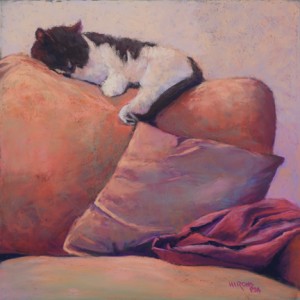On Monday I will be holding a discussion with my advanced class on the “wow” factor. I was first introduced to this concept by Richard McKinley at a workshop in 2008. And the Pastel Journal, in its April issue on the Pastel 100, has included a special article on the “wow” factor and what it means for jurists. They cover many things, but the one that seems to be at the center is the emotional factor. When a painting encompasses the “wow” factor it speaks to others. But lately, I’ve been thinking about a different concept–“pastel bliss”–to coin my own phrase. I experienced this last Monday when I did a small 6 x 12 painting in class. The composition came together nicely, I liked the colors, the surface and pastels were working well and every stroke brought enjoyment. And the one problem area was quickly resolved by pieces of grass that I love. (My photo of the painting didn’t work well, but it was filmed yesterday and I will share it when the disk is received.) For now, I’ll share the picture of my mother’s cat, Gracie, another painting that came together in two hours and basically painted itself. The difference that I’m speaking about is the impact on others of some paintings vs. the enjoyment we receive when we paint certain paintings. I guess that perfect bliss is achieved both the pleasure and the “wow” element are combined in the same painting. But sometimes, the pleasure alone is enough. When people ask me at a show what my favorite painting is, invariably it’s the one that I enjoyed painting the most. Others have no knowledge of this and assess the paintings based on their own experiences and how the paintings speak to them. This is as it should be. Which brings me back to the element of emotion in our paintings. This is very difficult for me to describe or define. I rarely like paintings that are too obviously meant to stir the emotions. So I think it’s something that comes from within, from the relationship we have to the subject matter. Last week’s painting was another snow picture from Mattapoisett, from a place I visit every time I’m there and near our first house. So I know the feeling of it well. Perhaps that translates as I’m painting. It’s definitely not a “wow” picture. It’s very quiet and I have no idea whether anyone else would find it emotionally appealing. But it speaks to me.


From what I understand….part of the “Wow” factor is how it emotionally speaks to the viewer, which will change from viewer to viewer according to their age, culture, sex, life experience and association with the subject. So it’s part subjective. Strong use of color and composition seem to be only a part of the equation. One person’s wow can be another person’s eh. I notice this when I win an award for an artwork in one show and don’t even jury into another with the same piece. After mastering composition, color and technical skill I think subjective personal influence plays a much larger role than we realize. I also notice the same names coming up again & again in magazine awards….safe trends come & go fashionably in the art circles too.
This is definitely the case. All of the Pastel 100 paintings are competent pictures, some better than others. But so much of judging comes from the juror and what that person relates to. And I do agree that we DO see the same names. But there are new ones too and that is encouraging. I’ll probably enter this year (didn’t last because of my book). Have entered for a number of years and have never gotten in. But it’s always been the landscape category, whch is the hardest.
Sorry to comment so often but I found this painting of the cat to be an excellent lesson on using complementary colors such as in the pillows. It is very helpful to me. Thank you.
Please–never apologize for commenting. You wouldn’t believe the number of spam messages I get and how poorly worded they are! I love hearing from “real” viewers, regardless the message and I’m glad that I’m connecting in whatever way.
I love your work and your commentaries and thoughts.
Am ordering your book v. soon.
I need time to read everything you have expressed so far and then more as time goes on.